 Image search results - "sakai" Image search results - "sakai" |
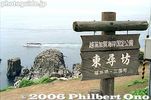
Tojinbo sign indicating the Echizen-Kaga Coastal Quasi-National Park
|
|

Maruoka Castle is Japan's oldest surviving castle tower although it collapsed during the Fukui Earthquake in 1948. Rebuilt in 1955 with most of the original materials. Originally built in 1576 by Shibata Katsutoyo, nicknamed Kasumiga-jo (Misty CastlePhoto: Way to Maruoka Castle from the bus stop.
|
|

Tojinbo in Mikuni-cho is spectacular, natural rock columns and walls on the coast. Hiking trails and boat rides give you a closer look at this rare natural monument. Tojimbo is accessible by bus from JR Awara Onsen Station on the Hokuriku Line.
|
|

Entrance to castle grounds
|
|

Huge rock columns stand about 9 stories (25 meters) high.
|
|

The stone marker says National Treasure Kasumiga-jo Castle.The castle was a National Treasure until it collapsed in the 1948 Fukui Earthquake. Now an Important Cultural Property.
|
|
|

Maruoka Castle tower
|
|

Bungee jumping is probably not possible here.
|
|

Maruoka Castle tower
|
|

Maruoka Castle tower
|
|
|

Path to castle tower
|
|

Maruoka Castle
|
|
|
|

Old shachi (killer whale) roof ornaments made of stone.The original shachi were made of wood with copper plating. But during WWII, the precious copper was taken and these two stone shachi were made to replace the original shachi. These two shachi fell off the roof during the 1948 earthquake and were replaced by a replica of the original made of wood and copper plating.
|
|

Steps to castle tower entrance.
|
|

Side of castle
|
|
|
|
|
|
|
|

Entrance to castle tower
|
|

1st floor of castle towerThe steep stairs go to the 2nd floor.
|
|

1st floor of castle tower
|
|

1st floor of castle tower with photos of other castles.
|
|

Old-style "bay window?"
|
|

"Sama" hole to shoot weapons (arrows or guns)
|
|

2nd floor
|
|

Roof tiles made of stone (rare)
|
|

Roof tiles made of stone (2nd floor)
|
|

Roof tiles made of stone on Maruoka Castle
|
|

Stairs to top floor
|
|

Stairway on top floor
|
|

Top floor
|
|

Top floor
|
|
|

Veranda (closed to visitors)
|
|

View from castle tower
|
|

The veranda is narrow and the fence is low.
|
|
|
|

Ceiling on top floor
|
|

Ceiling on top floor
|
|

Ceiling on top floor
|
|

Ceiling on top floor
|
|
|
|

Stairs going down
|
|
|

Well related to the castle's mist.
|
|

Lower stone wall
|
|
|
|
|

Folk History Museum adjacent to the castle. 歴史民俗資料館
|
|

Folk History Museum
|
|

Inside Folk History Museum
|
|

Edo Period currency
|
|
|
|

Kasumiga-jo Park, noted for cherry blossoms.
|
|

Bus stop for Maruoka CastleTakes about 40-50 min. from Fukui Station.
|
|
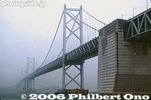
Foggy Seto Ohashi Bridge at Sakaide
|
|

Foggy Seto Ohashi Bridge at Sakaide
|
|

Foggy Seto Ohashi Bridge at Sakaide
|
|
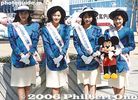
Miss Seto Ohashi for the Seto Ohashi Expo in 1988.
|
|
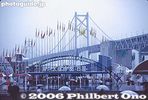
Seto Ohashi Expo in 1988
|
|

JR Shikoku Pavilion, Seto Ohashi Expo in 1988
|
|

Shikoku Pavilion, Seto Ohashi Expo in 1988
|
|
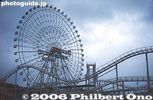
Ferris wheel, Seto Ohashi Expo in 1988
|
|

Seto Ohashi Expo in 1988
|
|
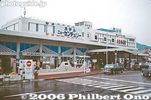
Old JR Sakaide Station. Notice the Seto Ohashi Bridge motif.
|
|

Otori Taisha (officially named "Otori Jinja") shrine is dedicated to Yamato Takeru (日本武尊), a very famous, legendary warrior prince. This is the headquarters shrine of all Otori shrines (大鳥神社) in Japan. Short walk from Otori Station (鳳駅) on the JR Hanwa Line that connects to Tennoji on the Osaka Loop Line.
|
|

The shrine is in the small forest named "Chigusa-no-mori." Not very many people were here so I thought it would be quick and easy to see this shrine. But I was wrong.
|
|
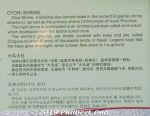
About Otori Taisha in English, Korean, and Chinese.
|
|

Entrance to Otori Taisha on New Year's Day 2019.
|
|

Suddenly the path to the shrine got crowded and later this line of people stopped movng. The first torii to Otori Taisha.
|
|

The path to the shrine is quite narrow. It took a while to get to the shrine as we inched along.
|
|

Much of the time we stood still. Didn't move much.
|
|

Barrels of sake offered to the shrine.
|
|

Standing still too often.
|
|

If you've never been to this shrine, it's impossible to tell how far or how near you are. The path makes a few turns.
|
|

This is a statue of Yamato Takeru (日本武尊) at Otori Taisha. He went around Japan and defeated his enemies until he finally met his demise on Mt. Ibuki in Shiga Prefecture where sought to kill an evil god. This god disguised himself as a white boar (another version says it was a serpent) who sprayed a poisonous mist that sickened Yamato Takeru.
He eventually died and when his body was cremated and buried in Kameyama in Mie Prefecture, his spirit rose from the ashes as a great white bird. This bird landed in a few places before finally landing here in Sakai, Osaka, where this Otori Shrine was built. "Otori" means "Big Bird" (not like Sesame Street, but more like a great swan or firebird).
|
|

I've noticed piles of trash at large Osaka shrines.
|
|

Wash basin, but hardly anyone used it. People didn't want to lose their place in line.
|
|

Getting closer the shrine on the left.
|
|

And closer...
|
|
|
|

Otori Taisha shrine's Haiden worship hall on New Year's Day 2019, Sakai, Osaka. 拝殿
|
|

Otori Taisha shrine's Haiden worship hall on New Year's Day 2019, Sakai, Osaka. 拝殿
|
|

Otori Taisha shrine's Haiden worship hall on New Year's Day 2019, Sakai, Osaka. 拝殿
|
|

Offertor pit at Haiden worship hall on New Year's Day 2019.
|
|

No wonder it took so long to get to the shrine. The praying area is quite narrow.
|
|

Patient people.
|
|

Back of the Haiden hall.
|
|

Especially popular was the omikuji.
|
|

Next to Otori Taisha's Haiden hall was this jumbo ema prayer tablet for the Year of the Boar 2019. A white boar steadily walking up a hill toward its goal symbolized by the rising sun.
|
|

This is Otori Taisha's regular-size ema prayer tablet for the Year of the Boar 2019.
|
|

Otori Taisha's ema prayer tablet for the white bird.
|
|

New Year's arrows.
|
|

Omikuji
|
|

You can walk around Otori Taisha's main shrine. Otori Taisha's architecture is called Otori-zukuri.
|
|

Otori Taisha shrine suffered major damage from Typhoon No. 21 in Sept.2018. Part of the roof on the main shrine was damaged.
|
|
|
|

The shrine suffered major damage from Typhoon No. 21 last Sept. Trees were damaged.
|
|

Secondary shrine for Amaterasu Sun Goddess and Sugawara Michizane. 大鳥美波比神社
|
|

Tree roots.
|
|

Torii for the back exit.
|
|

Stay away from brick walls if the earth starts to shake.
|
|

Otori Danjiri Matsuri is held in Oct. Similar to the one in Kishiwada.
|
|

Manhole in Sakai, Osaka.
|
|

Otori shopping arcade.
|
|

Otori shopping arcade, but the shops were closed on New Year's Day.
|
|

JR Otori Station. 鳳駅
|
|

JR Hanwa Line at JR Otori Station. 鳳駅
|
|

Inside JR Hanwa Line train.
|
|
|
|
|
|
|




















































































































